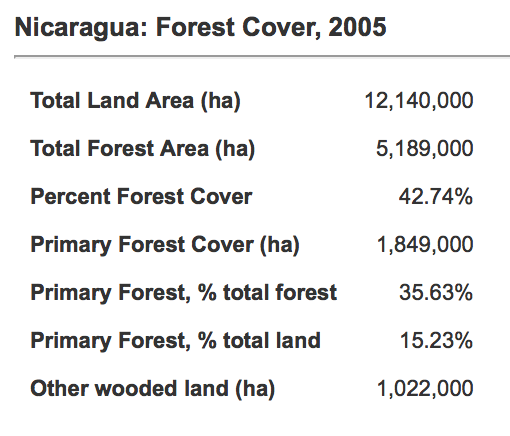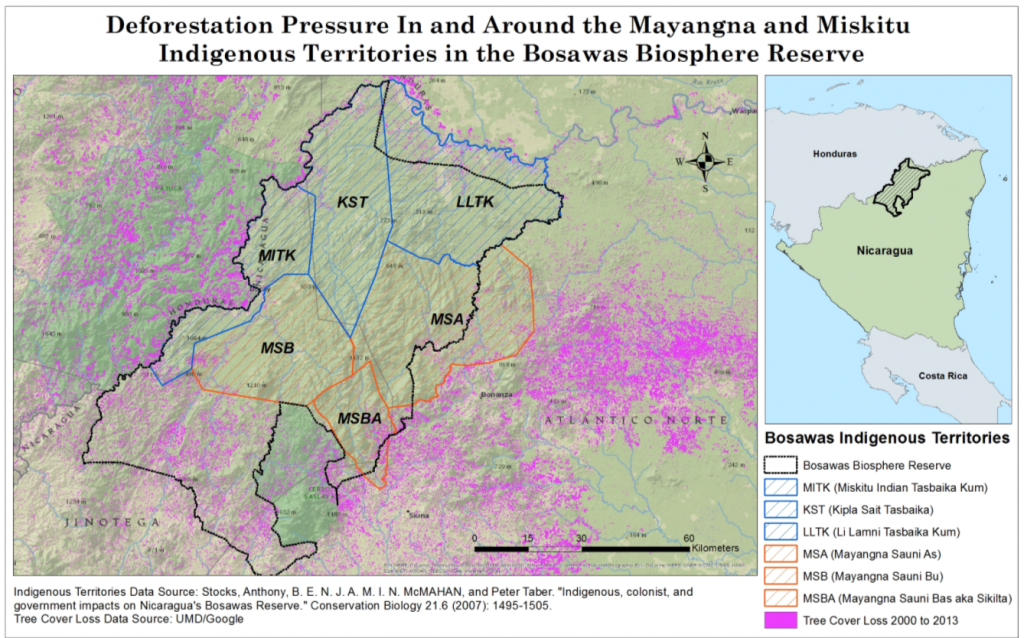
Overview of Geography
Nicaragua can be separated into 3 geographic regions: the Pacific lowlands located in the western part of Nicaragua, the Central Region and the Atlantic lowlands in the eastern side. In comparison to the Atlantic lowlands, which are rich in biodiversity, the Pacific Lowlands and the Central Region are lined with volcanoes and have some of the largest mountain ranges. More specifically, the northern central region is home to the Bosowas Biosphere Reserve with the beautiful Isabella Mountain chain passing through it. Filled with rich biodiversity, the Bosowas is also home to the Mayangna and Miskitu indigenous people.
Charts from Mongabay
Causes for Deforestation
Currently, Nicaragua has a forest cover of 7.9 million acres but loses 1.%of its forest cover per year (Rainforest Alliance) or  150,000 square km/year (Mowforth ). As seen in the table to the left from Mongabay International News, in 2005 the forestcover was at 42.74% but after only 5 years it decreased to 26%.
150,000 square km/year (Mowforth ). As seen in the table to the left from Mongabay International News, in 2005 the forestcover was at 42.74% but after only 5 years it decreased to 26%.
While Nicaragua is home to the largest tropical forests in the western Hemisphere outside of the Amazon (Rainforest Alliance), its natural beauty and biodiversity is being threatened by companies seeking economic gains. Such gains come from timber and agricultural production. While logging and agricultural practices have always contributed to small amounts of deforestation, their effects escalated in Nicaragua during the debt crisis of the 1980s (Mowforth 107). In an effort to repay much of its foreign debt, Nicaragua increased its agricultural and timber productions at the cost of its forestry. In order to keep up with the world’s demands for fruits, many corporations sought large pieces of land to set up plantations (Mowforth 107). They can easily take land away from campesinos and set up non-rotational farming systems for large-scale farming which depletes the soil of its nutrients faster, eventually causing them to look for more fertile soil (Mowforth 107).
Alongside agriculture, the increase in logging had its roots during the 1990s when the government made it easier for corporations to access land in tropical forests for timber. This resulted in 21% of the country’s forest cover being destroyed between 1990 and 2005 (Mongabay). In 1998 the president put into practice a five year law that banned logging of cedar, mahogany, and bombox trees but it was of little use because many large companies found loopholes and ways around such laws; thus, today 50% of all the timber produced comes from illegal logging (Mongabay).
Effects of Deforestation for Indigenous Communities
The local effects of deforestation can be seen in the events like Hurricane Mitch and Hurricane Felix that directly influence the indigenous people near the forests. In 2007, Hurricane Felix did more damage than it should have, drowning 1.2 million acres of forest in the RAAN (Northern autonomous region). The indigenous communities like the Miskito and Mayangna depend on the preservation of tropical forests for their well-being. This is the place that they depend on for food and as a home (rainforest alliance). Because of the importance that the tropical forests hold for the indigenous communities, they struggled to get the government and other organizations like the Nicaraguan Ministry of Environment and Natural Resources (MARENA) to legally recognize the forests in order to prevent conquest by colonists. These colonists would typically take over “unclaimed” land for personal use that required even more deforestation (Winterbottom). Efforts to stop colonists had been very minimal and it was always hindered by the economic ambitions of corporations and the Nicaraguan government itself. However, in 2002 new laws were adopted that favored the indigenous community and since then there have been many improvements concerning forest cover loss. The image below is from the World Resources Institute and shows how the efforts to legally recognize the lands of the autonomous regions have impacted forest cover. The image shows that land not recognized by the government have experienced a deforestation rate much greater than the lands occupied by indigenous community (Winterbottom).
Efforts to Prevent Deforestation
While large corporations are to blame for the high rates of deforestation, in 2006 the government was claimed to have protected the illegal logging of these companies. In order to control the situation, Daniel Ortega started several efforts in 2007 involving the army’s help and other environmental leaders. However, his efforts only applied to large public corporations and not to private enterprises so the illegal tactics continues (Mowforth 115).
Another measure used to aide in the fight of deforestation and global warming in Nicaragua is Carbon Sequestration. Since deforestation increases green house gas emissions (accounts for 15%), companies make up for it through a system called carbon trading. In carbon trading a company has a cap or a limit for the amount of carbon dioxide that it can emit. If it surpasses this limit it must participate in environmental projects to compensate for over pollution. However, this is not effective because corporations just gain more access to forests with the possibility of using it for more deforestation rather than the environmental projects (Mowforth 116).
Some effort have been made to prevent deforestation on both the local and national level. For example, the Federation of Secondary School student, the July 19th Sandinista Youth, and the National Forestry Institutes came together to form the National reforestation Campaign in 2010 with the goal of planting 1.5 million trees through the help of high school students (Mowforth 123).
The Forest Stewardship Council developed a timber certification system that would help to accurately label forest timber and as a result keep more control of their activity (Mowforth 123). However, this program has been very limited in its success in developing countries and part of the reason is that in countries like Nicaragua there is a lot of corruption in business. Many loopholes in the law allow big businesses to get away with illegal logging. Even people from the government form a part of these practices when they see an economic benefit for them.
Conclusion
Nicaragua is a country full of biodiversity and while I do recognize that its tropical forests can contribute much to the country’s economy in the short-term, it is important to remember the long term. The best way to make sure that deforestation rate doesn’t persist at such extreme magnitudes, it is important for the government to take action. As mentioned by Martin Mowforth in his chapter “Deforestation and Reforestation: Can’t See the Wood for the Trees”, countries like Nicaragua need to implement large-scale projects and get the government involved in order to really make an impact since the rate of deforestation is so high. We want these forests to continue to provide for the indigenous communities and keep being the pride of Nicaragua.
Sources:
1. Mongabay. “Statistics: Nicaragua.” Forest Data: Deforestation Rates and Related Forestry Figures. Mongabay, n.d. Web. 18 Nov. 2015.
2. Mongabay. “Tropical Rainforests: Deforestation Rates Tables and Charts.” Mongabay, n.d. Web. 18 Nov. 2015.
3. Mongabay. “Tropical Rainforests: Tropical Rainforests.” Mongabay. Mongabay, n.d. Web. 18 Nov. 2015.
4. Nicaragua Channel. “Mountain Ranges of Nicaragua.” Nicaragua Channel. Nicaragua Channel, n.d. Web. 16 Nov. 2015.
5. Mowforth, Martin. “Deforestation and Reforestation: Can’t See the Wood for the Trees.” The Violence of Development: Resource Depletion, Environmental Crises and Human Rights Abuses in Central America. New York: Pluto Press, 2014. 107-129. Print.
6. Winterbottom, Robert, Caleb Stevens, and Asa Strong. “Nicaragua’s Indigenous Peoples Protect Their Forests Even Without Government Support.” Nicaragua’s Indigenous Peoples Protect Their Forests Even Without Government Support. World Resource Institute, 14 Nov. 2014. Web. 18 Nov. 2015.



Experiencing a sense of being overwhelmed as your upcoming exams draw near? No need for apprehension – take my online exam for me here to provide assistance! Embrace our exceptional service geared towards managing your online exams on your behalf. Release your worries about exams as our adept team of experts stands prepared to offer you guidance. We will steer you towards success in your virtual exams, ensuring that the grades you merit are accomplished. Bid farewell to restless nights and stress, and welcome triumph with open arms. Entrust us with the responsibility of handling your online exams, allowing you to focus on your true priorities. Place your confidence in us to yield impressive results – the time has arrived to boldly conquer those exams!
Feeling the pressure of the looming exams? Keep your cool – we’re with you every step of the way! Opt for our premium take my online test for me offering and shed all exam-related tensions. Our dedicated experts are here to steer you through your online evaluations, targeting the peak scores you’ve set your heart on. Let go of the anxieties and those midnight cramming marathons. As we take charge of your online tests, you can channel your efforts towards the essentials. Bank on us for remarkable results – your stage to stand out in those exams has arrived!
Concerned about the upcoming exams? Breathe easy – we’ve got you covered! Experience peace with our leading take my online quiz for me solution and cast aside all test-related concerns. Our proficient team stands ready to guide you through your online challenges, aiming to capture the top scores you earnestly seek. Bid adieu to the sleepless nights and those cramming hours. With our oversight on your online assessments, redirect your energies to more pressing matters. Trust us to deliver standout performance – it’s your time to excel in those exams!
Tensed about the imminent exams? Relax – we’re in your corner! Delve into our esteemed take my test for me program and leave behind all test-related jitters. Our adept crew is geared up to support you through your online evaluations, striving to nab those high marks you’ve been eyeing. Break free from stress and those twilight revision hours. With us handling your online exams, you can concentrate on other priorities. Lean on us for unparalleled achievements – your spotlight moment in those exams is at hand!
“About Nicaragua: Deforestation” presents a critical environmental issue. Through story writing, one can illuminate the impact of deforestation on communities, wildlife, and ecosystems. The narrative story writing could follow characters fighting to preserve their forest, highlighting the consequences of human actions, and inspiring change. It has become a powerful medium to raise awareness about environmental conservation.
I highly recommend THE GHOST BOOK WRITERS for their professional ghostwriting services . I recently worked with them on my book project, and I was extremely impressed with their professionalism, expertise, and commitment to my vision.
Are you struggling to get your business noticed on Google Maps? Our Google My Business Optimization Service In Delhi can help! We’ll optimize your GMB listing with relevant keywords, photos, and reviews to improve your local SEO ranking. Reach more customers and grow your business with our expert GMB optimization service. Contact us today for a free consultation!
I read this article. I think You put a lot of effort to create this article. I appreciate your work. lale kiran coat